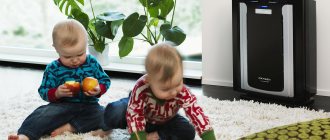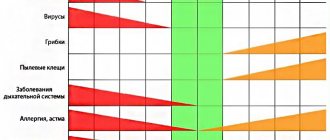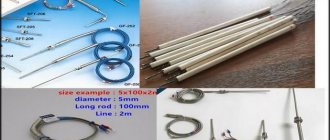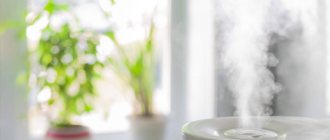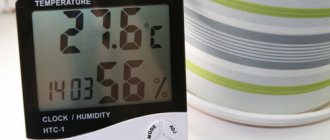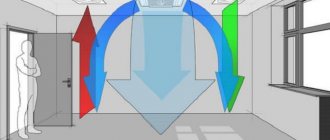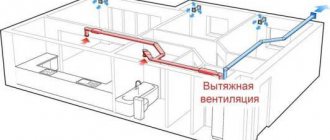Air humidity
Absolutely dry air almost never occurs in nature.
Some small amount of water is always present in the air and is usually in a gaseous state. Water vapor enters the air as a result of the evaporation of water from various surfaces. Most of the moisture in the atmosphere evaporates from the surface of the oceans, seas... and plants.
Composition of dry air
First of all, we can talk about the composition of dry air, that is, air that does not contain moisture at all.
Dry air, in its main part, contains nitrogen (N2) 72% and oxygen (O2) 21%. The remainder contains various gases in relatively small quantities.
The composition of dry air can be determined by the mass of gases in one m3 of air. In this case, we have the following values: N2 - 1.165 kg/m3, O2 - 1.331 kg/m3. These values are valid at a temperature of 20 °C and a pressure of 1 atm.
What should be the optimal humidity?
Humidity is especially important in places where people work, stay or sleep. Our respiratory organs are designed in such a way that air that is too dry or saturated with water vapor is harmful to them. This is why there are government standards that determine how dry indoor air should be.
Optimal humidity zone
GOST 30494-11 establishes a clear framework within which the microclimate of residential and public premises should be. In addition to the composition and optimal volume of air, humidity is also indicated.
Humidity 45% is optimal for a living room. In winter, this percentage is 30-45%. The maximum allowable value reaches 60%. In the warm season, this figure increases by 5%.
The same values apply to antiques, books, furniture, and electrical appliances. For plants, the optimal indoor humidity varies, as tropical and subtropical species love a moist, warm environment, while others prefer normal or dry conditions.
The optimal humidity level in children's rooms is 60%, but an increase or decrease of 10% is allowed.

Humidity depending on the room.
It is better to avoid restrictions, as they reduce efficiency and worsen health. It is quite possible to maintain an optimal microclimate in those rooms where we spend the most time.
Operating principle
The air is supplied to the fan in their room or from the street, depending on the position of the damper (shut-off and control device). A fan through a heater and several filters ensures the passage of air masses. At the same time, the installation can simultaneously humidify and heat the flows.
Most modern breathers can be controlled using smartphone applications. Literally any option has remote control bullets. In other words, the operation of the device can be carried out entirely automatically.
Measurement methods
Now it's time to find out how to measure the air humidity in an apartment. The choice is wide: from time-tested devices to modern electronic devices. The common name for all these devices is hygrometers. They can be used to determine other indicators, such as temperature.
When purchasing a device, pay attention to the range in which the main value is measured. The more there is, the better. The measurement error should be as small as possible, optimally within 1%.
Electronic devices are equipped with additional functions for humans - alarm clock, built-in memory, backlight at night, clock.
To determine the air humidity in the house, you can use auxiliary means. Take a glass of water and place it in the refrigerator for 3 hours to cool. Then remove the glass and place it on the table away from the tap. Condensation appears on the glass walls. It is necessary to monitor his condition. Three situations are possible.
- The condensation quickly evaporates, the glass surface becomes dry after 5-6 minutes. Additional humidification of the indoor air is required.
- Drops of water on the glass can hang down freely for 5 minutes. Relative humidity is normal.
- Condensation drips and forms a puddle underneath. Too wet.
Approximate measurements can be taken using a fir cone. If the scales are “wavy” and cannot keep up with each other, the air is excessively dry.
You can use a wet bulb bulb and a dry bulb bulb to measure humidity. A wet thermometer is obtained by wrapping the lower part (the flask with alcohol) with a piece of wet cloth, the end of which is constantly immersed in water. First, the difference between the readings of two thermometers is calculated, and then the humidity value is determined from the table. Such a device is called a psychrometer.
Knowing the basic concepts, you can determine the value of relative humidity if the dry-bulb reading matches the wet-bulb reading. In this case it is 100%. The greater the difference, the drier the air in the room.
What signs in an apartment indicate high or low humidity?
Various little things will help determine the humidity in an apartment.
You just need to pay attention
p, blockquote 25,0,0,0,0 —>
Condensation on the windows will be the first to indicate increased water content in the air. Everything in the house will become damp, and the furniture will begin to smell like wood. Then the sense of smell will begin to distinguish notes of rotting and decomposition, and a specific musty smell will appear.
Under such conditions, mold and mildew will quickly begin to develop, infecting household members with various diseases.
If children have diathesis, this may be the reason for the high moisture content in the air. Attacks of asthma, cough and headache can confirm this. If you don't take action, you can get more serious illnesses. Such as otitis media, bronchitis and decreased immune defense.
Cancer cells multiply faster in high humidity.
The state of the human body changes even with a lack of moisture. People get tired faster, become drowsy, and sweat excessively. This leads to drying out of all the mucous membranes of the body, which can have serious consequences.
p, blockquote 28,0,0,0,0 —>
If dust hanging in the air is clearly visible in the room, then the humidity level has dropped significantly. The air is dry and particles (under the weight of water) do not settle on objects, but are easily drawn into the lungs. Exacerbation of allergic reactions confirms this.
The importance of humidity in human life has been undeniably proven. Therefore, it would be wise to constantly monitor its norm. To do this, you can use both purchased measuring instruments and use the experience of your ancestors
Paying attention to everyday details will help you understand that deviations have occurred. This will allow you to quickly correct the situation and bring everything back to normal.
To do this, you can use both purchased measuring instruments and use the experience of your ancestors. Paying attention to everyday details will help you understand that deviations have occurred. This will allow you to quickly correct the situation and bring everything back to normal.
p, blockquote 30,0,0,0,0 —>
For more information, watch the video:
p, blockquote 31,0,0,0,1 —>
The well-being and health of its owners depends on the state of the microclimate in the apartment. The level of humidity is one of the main indicators characterizing the parameters of the air that people in the room breathe. Therefore, it must be periodically monitored. This indicator must remain at the level established by sanitary and hygienic standards.
Therefore, the residents of the house are faced with the question of how to determine the air humidity in the apartment. Various methods are used for this. Even without special instruments, anyone can measure the humidity level in a room. Existing methods will be discussed in detail below.
Humidity measuring instruments
Instruments that can be used to measure humidity are called hygrometers. There are several types of these devices: hair, condensation and psychrometric.
1. A hair hygrometer uses the property of hair to change its length under the influence of changes in humidity. The higher the humidity, the longer the hair. Typically hair from a horse's mane or long human hair is used. One end of the hair is attached to the body of the device, and the other to the indicator.
A hair hygrometer consists of a scale, a rotating mechanism with a pointer, and a hair rod.
A dew point hygrometer can be used to determine the absolute humidity of the air.
First, the dew point is determined using the dew point thermometer built into the device. Then, using a table containing the density and partial pressure of water vapor at various temperatures, determine the absolute humidity.
If the air temperature and absolute humidity are known, then the relative humidity can also be determined.
The design of a condensation hygrometer is shown. A tube with a flask and a thermometer is built into a small metal box. The thin front wall of the box was polished to make it easier to see the condensing water droplets. A thermal insulation gasket is attached to a metal ring that stiffens the thin front wall.
A condensation hygrometer contains a thermometer and a bulb immersed in a vessel containing a rapidly evaporating liquid, the vessel having a polished wall on which water from the air can condense.
The device is used as follows: a quickly evaporating liquid (alcohol, ether, etc.) is poured into the box and air is blown through the box using a blower. This leads to rapid evaporation of the liquid and a decrease in the temperature in the box. This causes dew to form on the polished front of the box. A thermometer measures the temperature at which dew condenses. The appearance of dew indicates that the water vapor has become saturated.
Absolute humidity is determined by reading a graph that shows the density and partial pressure of water vapor at various temperatures.
3. Such a device for measuring relative humidity is called a psychrometer. It consists of two identical thermometers mounted on a holder. The bottom of one of the thermometers is immersed in a small container containing a few milliliters of water. Typically, a psychrometric table is printed on the body of this device. Using this table, reading the readings of two thermometers, you can determine the relative humidity of the air.
4.To make a homemade psychrometer, you need to take two identical homemade alcohol thermometers.
At the bottom of each thermometer is a ball of liquid. This liquid expands as the temperature increases. Excess liquid from the ball flows up a thin tube, next to which the divisions of the temperature scale are marked. Typically the liquid used is colored alcohol (alcohol thermometer) or mercury (mercury thermometer).
The ball of one of the thermometers should be wrapped in a piece of cotton wool or a small cloth moistened with water at room temperature. We will call this thermometer a “wet” thermometer.
You don't need to do anything with the second thermometer. We will call this thermometer a “dry” bulb thermometer.
Place these thermometers close to each other. In a few minutes, the homemade psychrometer will be ready to measure humidity.
Absolute and relative air humidity
Absolute and relative humidity are often used.
Absolute humidity is the mass of water vapor present in one cubic meter of air.
Absolute humidity can be measured by the partial pressure of water vapor (p) at a certain temperature (T). In relation to partial pressure, Dalton's law applies, which states that the individual components of a gas mixture are called independent. Therefore, each component produces pressure:
pi=nikT,
and the total pressure is equal to the sum of the pressures of the components:
p=p01kT+p02kT+…+p0ikT=p1+p2+…+pi,
where pi is the partial pressure of the i-th gas component.
The equation p=p01kT+p02kT+…+p0ikT=p1+p2+…+pi represents Dalton's law. Based on the fact that humidity is the amount of water vapor in air (gas), the concept of partial pressure and Dalton's law can be very useful in the practical study of absolute humidity. Absolute humidity is also the density of water vapor (ρ) at the same temperature (T). As absolute humidity increases, water vapor moves closer and closer to the saturated vapor state.
The maximum absolute humidity at a given temperature is the mass of saturated water vapor per cubic meter of air.
Relative humidity is the ratio of absolute humidity to the maximum absolute humidity at a given temperature.
This value is expressed as a percentage:
β=ρρnp·100%=ppnp·100%,
where ρnp is the density of saturated vapor at a given temperature T, pnp is the pressure of saturated vapor at the same temperature. Under conditions of thermodynamic equilibrium of the processes of evaporation and condensation, the relative humidity is 100%. From this we can conclude that the amount of water in the air does not change. The processes of isochoric cooling or isothermal compression of unsaturated steam transform it into saturated steam.
The temperature (Tr) at which steam is considered saturated is called the dew point.
Tr is the thermodynamic equilibrium temperature between vapor and liquid in a gas, particularly air.
Air humidity is determined by special instruments - hygrometers, psychrometers. The optimal relative humidity for the human body at a temperature close to 20 degrees Celsius is from 40 to 60%. When solving practical problems, we often use reference tables that indicate the pressure and density of saturated water vapor at various temperatures.
RH standards for an apartment:
Recommended STATE STANDARD GOST 30494-96 Indoor air humidity depending on the time of year:
- in winter - 30-45%;
- In summer - 30-60%.
- In autumn and spring - 30-45%;
Optimal indoor humidity for people of different ages:
- for adults - from 40 to 60%;
- for children under 6 years old - 50-60%.
The ideal humidity in an apartment for a person varies depending on the purpose of the room:
- in the bathroom, where the finishing of ceilings, walls and floors is usually waterproof, humidity can reach 60-70%;
- in rooms where there are plants, the humidity cannot be lower than 60-70%; for tropical and subtropical flowers it can reach 80-95%, so it’s worth taking them out to the balcony or loggia or creating a separate room for them
- there is no point in regulating the humidity on a balcony or loggia, since the premises are non-residential.
- The normal level of humidity in kitchens, hallways and pantries is 40-60%;
According to SanPiN 2.1.2.2645-10, the relative air humidity in the room decreases to 60% in the cool season and to 65% in the summer. Some rooms are not rated due to intermittent or short-term occupancy, as well as frequent and long-term changes in indoor humidity.
| Number assignment | Air temperature, °C | Relative humidity %. |
| winter | ||
| Living room | 18-24 | 60 |
| Rooms in areas with the coldest 5-day period (minus 31°C or below) | 20-24 | 60 |
| Kitchen | 18-26 | H/N* |
| Toilet | 18-26 | N/A |
| Bathroom, toilet | 18-26 | N/A |
| Lobby | 14-20 | N/A |
| Pantry | 12-22 | N/A |
| summer | ||
| Living room | 20-28 | 65 |
* - not adjustable.
To increase the service life of household appliances, books, paintings, upholstery, the humidity level should not exceed 60-65%.
Humidity levels in a child's room:
The optimal air humidity for a child in an apartment is determined by his age. This is especially important for newborns:
- Specifics of thermoregulation in infants. The drier the air (that the child breathes), the more moisture the body uses. This leads to greater loss of water - dryness of the nasopharynx and nasal cavity and difficulty breathing in the child. As a result, he wakes up more often at night, eats poorly, and is capricious.
- The heating season lasts a long time. The heating season in most Russian cities lasts at least 6 months a year. Central heating radiators can reduce the initial humidity levels in a room by 20-40% or more. Low air humidity during the heating season means frequent respiratory diseases, chronic rhinitis and an increased risk of developing bronchial asthma.

Depending on the age of your child, determine what humidity should be in the bedroom. For children in the first year of life, the optimal parameter is 50-70%, for children from 1 to 3 years old - 45-65%, for children over 3 years old, almost adult norms are suitable - 50-60%.
How to increase air humidity using household appliances and folk remedies
The most affordable and popular device for increasing air humidity is a home humidifier. It can be used throughout the year, but will be especially useful in winter, when indoor humidity of 20% causes discomfort.
There are the following types of humidifiers:
- Classic. The operating principle of such devices is based on the evaporation of cold water without preheating. Water flows from a special container into the evaporator - disk, filter or cartridge. Due to the fact that these devices draw air from the room and release it after cleaning the filter, additional dust and allergens are removed.
- Humidifiers with air purification function. These are devices that simultaneously increase the level of humidity and purify the air, equipped with special replaceable filters. They are also called air washers.
- Steam models. The operating principle of such devices is similar to the operating principle of an electric kettle. Heating elements with a ceramic plate or coil that release steam when heating water. It is optimal for use in summer, and for maintaining humidity standards in the apartment in winter.
- Ultrasound. The most expensive and most effective. The liquid poured into the reservoir is placed on a plate that vibrates under the influence of ultrasound. The water is broken into tiny droplets, which enter the room through the radiator inside the housing.
Humidifier with cleaning function (air washing) Steam humidifier Ultrasonic air humidifier
Using such devices, you can not only create comfortable humidity in the apartment, but also regulate other parameters:
- control temperature;
- stops dust and allergens.
- Neutralizes pathogenic microorganisms;
The effect of a humidifier can spread to different surfaces, which should be taken into account when purchasing. Small units are suitable for bedrooms or kitchens. Living rooms or other large spaces require a powerful device.
Humidity in a dry room can be increased using traditional methods:
- Frequent ventilation (not at sub-zero temperatures), especially after rain;
- Reducing the heating intensity of radiators using wet towels;
- Using a spray gun.
- regular wet cleaning;
- arrange flowers and water them regularly;
- installation of mini-fountains, aquariums or other water reservoirs;

To increase indoor humidity, you can dry clothes directly in the room, and not on the balcony or outside. When cooking, steam from boiling pots also gets released into the air.
Functionality
Modern supply and exhaust networks can have various functions. Including:
- Heating and cooling of incoming air;
- Purification of incoming air masses to safety standards;
- Removal of impurities, filtration and disinfection;
- Reduced humidity levels.
It is possible to install a recuperator to use the heat of the exhaust air and reduce the cost of heating the incoming air flows.
Ventilation can be installed, including with additional devices, on the facade of the building, in the attic or, for example, on the balcony. In our company you can order the installation of a supply and exhaust network both for one room and for all rooms of the cottage.
How to reduce humidity
High humidity is not always beneficial. If there is mold, mildew on the walls, or condensation constantly collects, it is necessary to reduce this. You can use one of these methods:
- Dehumidifiers. Special devices that absorb excess water molecules, drawing air out of the room. This type of device works by condensing water vapor in the room. To some extent, the function of a dehumidifier is performed by an air conditioner, which also takes water from the air.
- Good ventilation. Clogged ventilation ducts do not perform the function of removing excessively humid air from the apartment.
- Dry your clothes outside or on the balcony. When fabrics dry, they release water molecules into the air, which circulate throughout the room and increase humidity.
- Sunlight. When sunlight enters a room, it causes water to evaporate, so it is recommended to open windows regularly.
Some factors that increase humidity are beyond our control:
- The more people live in the apartment, the lower this figure will be;
- In some cities, climatic conditions determine constantly high levels of humidity.
- If all windows face north, the rooms are more susceptible to moisture;
Where is it recommended to install recuperators?
A recuperator can be installed in any building. However, they are especially recommended in hospitals, hotels, shopping centers, office and commercial facilities. The main calculated humidity load in such cases is the moisture that comes into the premises along with ventilation air in humid and warm weather. If a recuperator is installed in the ventilation system, the device will begin to take a significant volume of moist steam from the ventilation air masses until the latter are in the room. It will subsequently transfer this volume of moisture to the drier exhaust air removed from the room.
- Breezers
Breezers differ in functionality. The compact equipment combines the options of a professional air purifier and a full-fledged supply ventilation system. The technique is capable of:
- Provide air flow or recirculation;
- Purify air masses;
- Warm up and humidify (if such a function is available) air flows.
Please note: Breathers cannot cool the air.
Despite their small size, breathers can provide purified and fresh air heated to a comfortable temperature in a room with an area of up to 50-75 square meters. m. In our company you can order models of various capacities - managers will help you determine the optimal performance of the equipment.
If it is necessary to ventilate a large cottage, several breathers can be installed.
